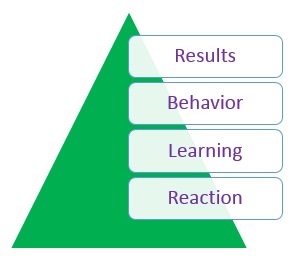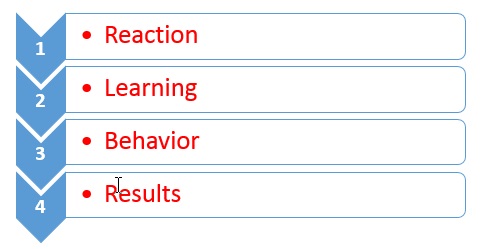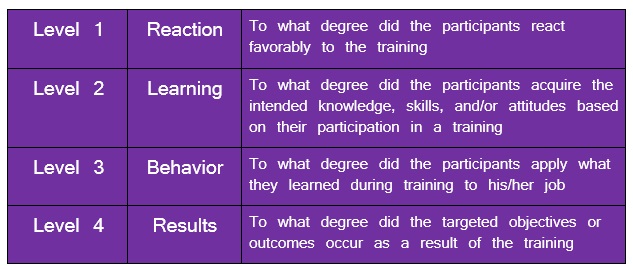Kirkpatrick’s Four Levels of Evaluation Model
Donald Kirkpatrick first published his Four Level Training Evaluation Model in 1959. To this day, it is still one of the most popular models to evaluate training program.
Kirkpatrick’s four levels of evaluation model evaluates the effectiveness of the training at four different levels with each level building on the previous level(s). All four levels of evaluation have their own elements, significance, benefits, and challenges.
The four levels of evaluation are:
According to Kirkpatrick’s’ model, evaluation is a series of steps that begins with level one, and moves sequentially through the levels to level four. Each level provides valuable information to help determine the effectiveness of the overall training program. However, as you proceed through each of the levels, the evaluation becomes more challenging, more expensive, and requires more time to complete.
By analyzing each of these four levels, a thorough understanding can be gained of how effective the training was, and how to improve some of the aspects of the training for future training events.
Kirkpatrick’s model includes four levels or steps of evaluation:
Kirkpatrick’s Four Levels of Evaluation
Level 1 – Reaction
This level measures how the participants reacted to the training event.
This level is important because it helps to understand how well the training was received by the participants. At this level, we not only want to know if the participants felt that the overall training program was a valuable experience, but we also want to know their reactions regarding specific components of the program, such as the instructor, the topics, the presentation style, the pace, and reference materials. Ideally, their reactions should be measured immediately after the program.
Getting measurements on their reaction to specific aspects or components of the training program can provide information on what improvements can be implemented for future training events. It can help to gain insight into whether to change the presentation formant, add or remove content, extend the session, or modify another component of the training.
This level of evaluation is generally easy to create, easy to implement, and inexpensive. This level typically relies on the use of surveys or questionnaires (“happy sheets”).
Information generally sought at this level include:
- Did the participants enjoy the training?
- Did they consider the training relevant to their job responsibilities?
- Was the training a valuable use of their time?
- Did they find the material useful?
- Did they find the instructor knowledgeable?
- Did the session accomplish its objectives?
- Did they like the venue and presentation style?
- Did the training session accommodate their personal learning style?
- Did the session move at a good pace?
- Did they feel they had the opportunity the practice a new skill or demonstrate their knowledge?
Level 2 – Learning
Level two evaluation measures what the participants have learned as a result of the training.
Similar to level one evaluation, level two evaluation should be done immediately following the training event to determine if participants gained the expected knowledge, skills, or attitudes.
Achievement tests or practice activities are often used to assess the amount of learning that has occurred and the extent to which the participant has advanced in skills, knowledge, or attitude. Since training sessions are usually designed with specific learning objectives, these objectives can be the basis for the measurement of the new knowledge, skills, or attitudes. The test or assessment should focus on measuring what was covered during the training event.
In some instances, it may be helpful to measure the knowledge base both before and then after training. By having these two measurements, it is easier to determine what the participants actually learned as a result of the training.
Level 3 – Behavior
Level three measures how much participants have changed their behavior as a result of the training they received.
Basically, this level is designed to determine if the newly acquired skills, knowledge, or attitude are being used in the everyday environment of the learner. At this level, we not only want to find out if the desired behavior change occurred, but if it did not occur, we also want to find out why the change did not occur.
Information generally sought include:
- Did the learners put their learning into effect back on the job?
- Are the learners aware that they have changed their behavior?
- Was there noticeable and measurable change in the activity and performance of the participants in their job roles?
- Are the learners able to teach their new knowledge, skills, or attitudes to other people?
- Was the change in behavior sustained over time?
- Was the change in behavior supported by others in the organization?
It is important to note that just because behavior has not changed does not mean that the training was ineffective.
This is why it is important to complete the first two levels of Kirkpatrick’s model and to complete them immediately after the training event. If only the behavior is evaluated, and it is determined that no behavior change has taken place, it may be incorrectly assumed that participants have not learned anything from the training. But, by completing the first two levels, it may show that there was a positive reaction to the training and that the participants learned from the training event.
Level 4 – Results
Level four evaluation measures the impact of training and subsequent reinforcement by the organization on business results.
Frequently referred to as the “bottom line” results, level four often measures tangible results such as increased production, decreased cost, improved quality, increased sales, higher efficiency, and higher profits. Most organizations utilize bottom-line results in their decisions to either continue, modify, or discontinue an approach or strategy.
Level four evaluation also includes outcomes that an organization has determined to be good for business or good for the employees. This may include such things as increased employee retention, greater job satisfaction, higher morale, fewer grievances, higher quality of work life, and increased customer satisfaction.
Level four evaluation is the most challenging of the evaluations. Level four evaluation is difficult to establish conclusive evidence that a training program was an essential piece in producing the desired outcomes. Most times, the desired measurements are already in place via normal management systems and statistical reporting methods, but the challenge is to directly link those results to the training.
Additional Links
Gagnes Nine Events Instruction



